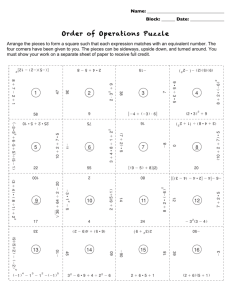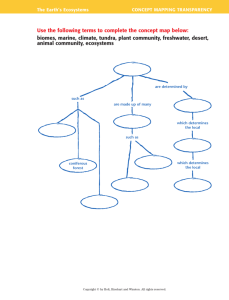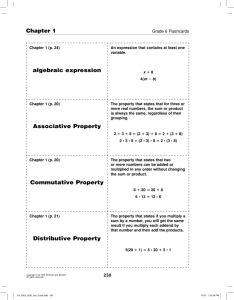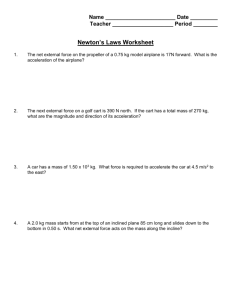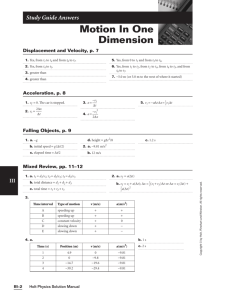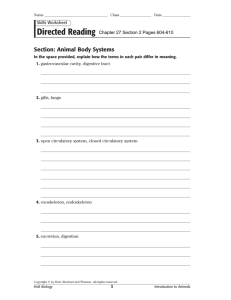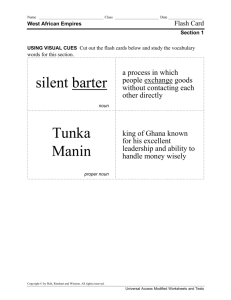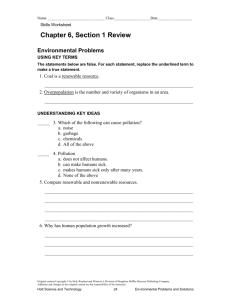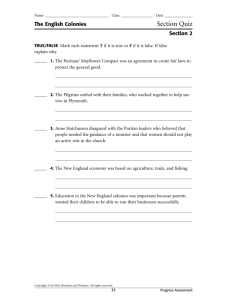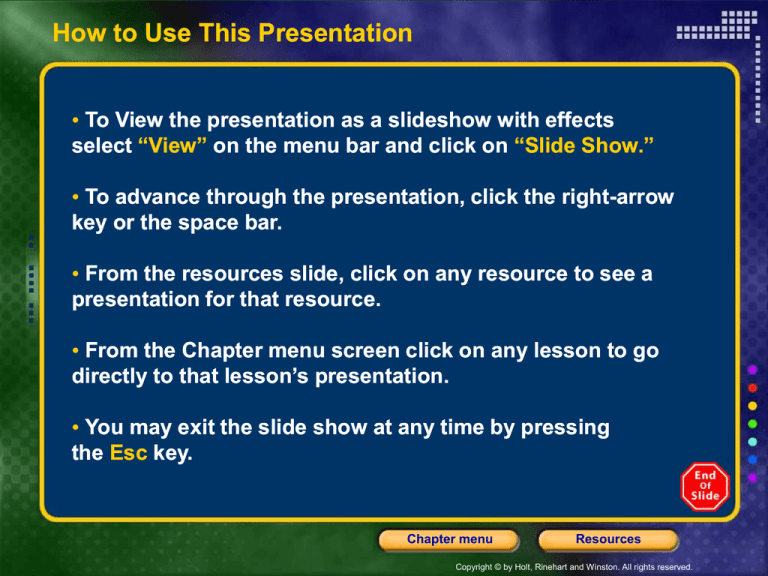
How to Use This Presentation
• To View the presentation as a slideshow with effects
select “View” on the menu bar and click on “Slide Show.”
• To advance through the presentation, click the right-arrow
key or the space bar.
• From the resources slide, click on any resource to see a
presentation for that resource.
• From the Chapter menu screen click on any lesson to go
directly to that lesson’s presentation.
• You may exit the slide show at any time by pressing
the Esc key.
Chapter menu
Resources
Copyright © by Holt, Rinehart and Winston. All rights reserved.
Resources
Bellringers
Chapter Presentation
Transparencies
Standardized Test Prep
Visual Concepts
Image and Math Focus Bank
Chapter menu
Resources
Copyright © by Holt, Rinehart and Winston. All rights reserved.
Chapter 18
Interactions of Living Things
Table of Contents
Section 1 Everything Is Connected
Section 2 Living Things Need Energy
Section 3 Types of Interactions
Chapter menu
Resources
Copyright © by Holt, Rinehart and Winston. All rights reserved.
Chapter 18
Section 1 Everything Is Connected
Bellringer
Think of all the things that make up a pond in the
countryside. List all the parts of the pond’s
ecosystem in your science journal. Are all the
parts of the ecosystem living? Explain your
answer.
Chapter menu
Resources
Copyright © by Holt, Rinehart and Winston. All rights reserved.
Chapter 18
Section 1 Everything Is Connected
Objectives
• Distinguish between the biotic and abiotic parts of
the environment.
• Explain how populations and communities are
related.
• Describe how the abiotic parts of the environment
affect ecosystems.
Chapter menu
Resources
Copyright © by Holt, Rinehart and Winston. All rights reserved.
Chapter 18
Section 1 Everything Is Connected
Studying the Web of Life
• Ecology is the study of the interactions of organisms
with one another and with their environment.
• The Two Parts of the Environment All of the
organisms that live together and interact with one
another make up the biotic part of the environment.
The abiotic part of the environment consists of the
nonliving factors.
Chapter menu
Resources
Copyright © by Holt, Rinehart and Winston. All rights reserved.
Chapter 18
Section 1 Everything Is Connected
Studying the Web of Life, continued
• Organization in the Environment At first glance,
the environment may seem disorganized. However,
the environment can be arranged into different
levels. The five levels of the environment are shown
on the next slide.
Chapter menu
Resources
Copyright © by Holt, Rinehart and Winston. All rights reserved.
Chapter 18
Section 1 Everything Is Connected
Chapter menu
Resources
Copyright © by Holt, Rinehart and Winston. All rights reserved.
Chapter 18
Section 1 Everything Is Connected
Studying the Web of Life, continued
• Populations Each animal is a part of a population,
or a group of individuals of the same species that live
together.
• Communities A community consists of all of the
populations of species that live and interact in an
area.
Chapter menu
Resources
Copyright © by Holt, Rinehart and Winston. All rights reserved.
Chapter 18
Section 1 Everything Is Connected
Studying the Web of Life, continued
Chapter menu
Resources
Copyright © by Holt, Rinehart and Winston. All rights reserved.
Chapter 18
Section 1 Everything Is Connected
Studying the Web of Life, continued
• Ecosystems An ecosystem is made up of a
community of organisms and the abiotic environment
of the community.
• The Biosphere The biosphere is the part of Earth
where life exists. It extends from the deepest parts of
the ocean to high in the air where plant spores drift.
Chapter menu
Resources
Copyright © by Holt, Rinehart and Winston. All rights reserved.
Chapter 18
Section 2 Living Things Need Energy
Bellringer
Indian pipe is a plant that is completely white—it has
no chlorophyll or chloroplasts to give it a green color.
Do you think this plant could be a producer? If not,
where do you think it could get the energy it needs to
survive?
Write your answers in your science journal.
Chapter menu
Resources
Copyright © by Holt, Rinehart and Winston. All rights reserved.
Chapter 18
Section 2 Living Things Need Energy
Objectives
• Describe the functions of producers, consumers,
and decomposers in an ecosystem.
• Distinguish between a food chain and a food web.
• Explain how energy flows through a food web.
• Describe how the removal of one species affects
the entire food web.
Chapter menu
Resources
Copyright © by Holt, Rinehart and Winston. All rights reserved.
Chapter 18
Section 2 Living Things Need Energy
The Energy Connection
• Producers Organisms that use sunlight directly to
make food are called producers. They do this by using
a process called photosynthesis.
• Consumers Organisms that eat other organisms
are called consumers.
• Decomposers Organisms that get energy by
breaking down dead organisms are called
decomposers.
Chapter menu
Resources
Copyright © by Holt, Rinehart and Winston. All rights reserved.
Chapter 18
Section 2 Living Things Need Energy
The Energy Connection, continued
Chapter menu
Resources
Copyright © by Holt, Rinehart and Winston. All rights reserved.
Chapter 18
Section 2 Living Things Need Energy
The Energy Connection, continued
Chapter menu
Resources
Copyright © by Holt, Rinehart and Winston. All rights reserved.
Chapter 18
Section 2 Living Things Need Energy
Comparing Consumers and Producers
Click below to watch the Visual Concept.
Visual Concepts
You may stop the video at any time by pressing
the Esc key.
Chapter menu
Resources
Copyright © by Holt, Rinehart and Winston. All rights reserved.
Chapter 18
Section 2 Living Things Need Energy
The Energy Connection, continued
• Food Chains and Food Webs A food chain is a
diagram that shows how energy in food flows from
one organism to another. A food web is a diagram
that shows the feeding relationships between
organisms in an ecosystem.
Chapter menu
Resources
Copyright © by Holt, Rinehart and Winston. All rights reserved.
Chapter 18
Section 2 Living Things Need Energy
The Energy Connection, continued
Chapter menu
Resources
Copyright © by Holt, Rinehart and Winston. All rights reserved.
Chapter 18
Section 2 Living Things Need Energy
The Energy Connection, continued
• Energy Pyramids An energy pyramid is a
triangular diagram that shows an ecosystem’s loss
of energy, which results as energy passes through
the ecosystem’s food chain.
Chapter menu
Resources
Copyright © by Holt, Rinehart and Winston. All rights reserved.
Chapter 18
Section 2 Living Things Need Energy
Chapter menu
Resources
Copyright © by Holt, Rinehart and Winston. All rights reserved.
Chapter 18
Section 2 Living Things Need Energy
Wolves and the Energy Pyramid
• Gray Wolves and the Food Web Gray wolves
were brought back to Yellowstone National Park in
1995. The U.S. Fish and Wildlife Service thinks the
return of the wolves will restore the natural energy
flow in the area and bring populations back into
balance.
• Balance in Ecosystems All organisms in a food
web are important for the health and balance of all
other organisms in the food web.
Chapter menu
Resources
Copyright © by Holt, Rinehart and Winston. All rights reserved.
Chapter 18
Section 3 Types of Interactions
Bellringer
Make a list of predators that are also prey.
Record your answer in your science journal.
Chapter menu
Resources
Copyright © by Holt, Rinehart and Winston. All rights reserved.
Chapter 18
Section 3 Types of Interactions
Objectives
• Explain the relationship between carrying capacity
and limiting factors.
• Describe the two types of competition.
• Distinguish between mutualism, commensalism,
and parasitism. Give an example of coevolution.
Chapter menu
Resources
Copyright © by Holt, Rinehart and Winston. All rights reserved.
Chapter 18
Section 3 Types of Interactions
Interactions with the Environment
• Limiting Factors A resource that is so scarce
that it limits the size of a population is called a
limiting factor.
• Carrying Capacity The largest population that
an environment can support is known as the
carrying capacity.
Chapter menu
Resources
Copyright © by Holt, Rinehart and Winston. All rights reserved.
Chapter 18
Section 3 Types of Interactions
Limiting Factors and Carrying Capacity
Click below to watch the Visual Concept.
Visual Concept
You may stop the video at any time by pressing
the Esc key.
Chapter menu
Resources
Copyright © by Holt, Rinehart and Winston. All rights reserved.
Chapter 18
Section 3 Types of Interactions
Interactions Between Organisms
• Individuals and Populations Interact Populations
contain individuals of a single species that interact
with one another, such as a group of rabbits feeding in
the same area.
• Communities contain interacting populations, such
as a coral reef with many species of corals trying to
find living space.
Chapter menu
Resources
Copyright © by Holt, Rinehart and Winston. All rights reserved.
Chapter 18
Section 3 Types of Interactions
Competition
• Individuals and Populations Interact When two
or more individuals or populations try to use the
same resource, such as food, water, shelter, space,
or sunlight, it is called competition.
• Competition can happen within a population, or
between populations.
Chapter menu
Resources
Copyright © by Holt, Rinehart and Winston. All rights reserved.
Chapter 18
Section 3 Types of Interactions
Predators and Prey
• Predators are organisms that eat all or part of
another organism. Organisms that are killed and
eaten by other organisms are called prey.
• Predator Adaptations To survive, predators must
be able to catch their prey. Predators have a wide
variety of methods and abilities for doing so.
Chapter menu
Resources
Copyright © by Holt, Rinehart and Winston. All rights reserved.
Chapter 18
Section 3 Types of Interactions
Predators and Prey, continued
• Prey Adaptations Prey have their own methods
and abilities to keep from being eaten. Prey are able
to run away, stay in groups, or camouflage
themselves. Some prey are poisonous.
• Camouflage One way animals avoid being eaten
is by being hard to see. Blending in with the
background is called camouflage.
Chapter menu
Resources
Copyright © by Holt, Rinehart and Winston. All rights reserved.
Chapter 18
Section 3 Types of Interactions
Predators and Prey, continued
• Defensive Chemicals Some animals defend
themselves with chemicals. The skunk and the
bombardier beetle both spray predators with irritating
chemicals. Bees, ants, and wasps inject a powerful
acid into their attackers.
• Warning Coloration Animals that have a chemical
defense need a way to warn predators that they
should look elsewhere for a meal. Their chemical
weapons are often advertised by warning colors.
Chapter menu
Resources
Copyright © by Holt, Rinehart and Winston. All rights reserved.
Chapter 18
Section 3 Types of Interactions
Symbiosis
• Symbiosis is a relationship in which two
different organisms live in close association with
each other.
• Mutualism is a symbiotic relationship in which
both organisms benefit.
• Commensalism is a symbiotic relationship in
which one organism benefits and the other is
unaffected.
Chapter menu
Resources
Copyright © by Holt, Rinehart and Winston. All rights reserved.
Chapter 18
Section 3 Types of Interactions
Symbiosis, continued
• Parasitism is a symbiotic association in which
one organism benefits while the other is harmed.
• The organism that benefits is called the parasite,
while the organism that is harmed is called the
host.
Chapter menu
Resources
Copyright © by Holt, Rinehart and Winston. All rights reserved.
Chapter 18
Section 3 Types of Interactions
Coevolution
• What Is Coevolution? When a long-term change
takes place in two species because of their close
interactions with one another, the change is called
coevolution.
• Coevolution and Flowers Flowers have
changed over millions of years to attract pollinators.
Pollinators such as bees, bats, and hummingbirds
can be attracted to a flower because of its color,
odor, or nectar.
Chapter menu
Resources
Copyright © by Holt, Rinehart and Winston. All rights reserved.
Chapter 18
Interactions of Living Things
Concept Map
Use the terms below to complete the concept map on
the next slide.
Chapter menu
Resources
Copyright © by Holt, Rinehart and Winston. All rights reserved.
Chapter 18
Interactions of Living Things
Chapter menu
Resources
Copyright © by Holt, Rinehart and Winston. All rights reserved.
Chapter 18
Interactions of Living Things
Chapter menu
Resources
Copyright © by Holt, Rinehart and Winston. All rights reserved.
End of Chapter 18 Show
Chapter menu
Resources
Copyright © by Holt, Rinehart and Winston. All rights reserved.
Chapter 18
Standardized Test Preparation
Reading
Read each of the passages. Then, answer the
questions that follow each passage.
Chapter menu
Resources
Copyright © by Holt, Rinehart and Winston. All rights reserved.
Chapter 18
Standardized Test Preparation
Passage 1 Two or more individuals trying to use the
same resource, such as food, water, shelter, space, or
sunlight, is called competition. Because resources are
in limited supply in the environment, the use of them
by one individual or population decreases the amount
available to other organisms. Competition also occurs
between individuals within a population. The elk in
Yellowstone National Park are herbivores that compete
with each other for the same food plants in the park.
Chapter menu
Resources
Copyright © by Holt, Rinehart and Winston. All rights reserved.
Chapter 18
Standardized Test Preparation
1. According to the passage, competition occurs
between which of the following?
A individuals trying to use the same resource
B elk and carnivores
C food and shelter
D individuals trying to use different resources
Chapter menu
Resources
Copyright © by Holt, Rinehart and Winston. All rights reserved.
Chapter 18
Standardized Test Preparation
1. According to the passage, competition occurs
between which of the following?
A individuals trying to use the same resource
B elk and carnivores
C food and shelter
D individuals trying to use different resources
Chapter menu
Resources
Copyright © by Holt, Rinehart and Winston. All rights reserved.
Chapter 18
Standardized Test Preparation
2. According to the passage, food, water, shelter, space,
and sunlight are examples of
F populations.
G things found in Yellowstone National Park.
H competition.
I resources.
Chapter menu
Resources
Copyright © by Holt, Rinehart and Winston. All rights reserved.
Chapter 18
Standardized Test Preparation
2. According to the passage, food, water, shelter, space,
and sunlight are examples of
F populations.
G things found in Yellowstone National Park.
H competition.
I resources.
Chapter menu
Resources
Copyright © by Holt, Rinehart and Winston. All rights reserved.
Chapter 18
Standardized Test Preparation
3. Based on the passage, which of the following
statements is a fact?
A Competition occurs only between individuals of
different populations.
B Competition occurs between individuals within a
population and between individuals of different
populations.
C Competition increases the amount of resources
available to individuals.
D Because resources are abundant in the
environment, competition rarely happens between
individuals of different population.
Chapter menu
Resources
Copyright © by Holt, Rinehart and Winston. All rights reserved.
Chapter 18
Standardized Test Preparation
3. Based on the passage, which of the following
statements is a fact?
A Competition occurs only between individuals of
different populations.
B Competition occurs between individuals within a
population and between individuals of different
populations.
C Competition increases the amount of resources
available to individuals.
D Because resources are abundant in the
environment, competition rarely happens between
individuals of different populations.
Chapter menu
Resources
Copyright © by Holt, Rinehart and Winston. All rights reserved.
Chapter 18
Standardized Test Preparation
Passage 2 In the deserts of northern Africa and the
Middle East, water is a scarce and valuable resource.
In this area, no permanent streams flow except for the
Nile. More than 1.6 million square kilometers of this
region typically have no rainfall for years at a time.
However, much of this area has large aquifers. The
water that these aquifers contain dates back to much
wetter times thousands of years ago. Occasionally,
water reaches the surface to form an oasis. Wells
supply the rest of the water used throughout the
region. In some regions of Saudi Arabia and Kuwait,
wells drilled for water more often strike oil.
Chapter menu
Resources
Copyright © by Holt, Rinehart and Winston. All rights reserved.
Chapter 18
Standardized Test Preparation
1. According to the passage, an aquifer contains what
resource?
A oil
B water
C wells
D oasis
Chapter menu
Resources
Copyright © by Holt, Rinehart and Winston. All rights reserved.
Chapter 18
Standardized Test Preparation
1. According to the passage, an aquifer contains what
resource?
A oil
B water
C wells
D oasis
Chapter menu
Resources
Copyright © by Holt, Rinehart and Winston. All rights reserved.
Chapter 18
Standardized Test Preparation
2. Based on the passage, which of the following
statements is a fact?
F The Nile no longer flows through northern Africa and
the Middle East.
G The water found in aquifers is from recent rainfall.
H Wells drilled in Saudi Arabia and Kuwait are more
likely to strike oil than water.
I The desert regions of northern Africa and the Middle
East receive rainfall almost every day.
Chapter menu
Resources
Copyright © by Holt, Rinehart and Winston. All rights reserved.
Chapter 18
Standardized Test Preparation
2. Based on the passage, which of the following
statements is a fact?
F The Nile no longer flows through northern Africa and
the Middle East.
G The water found in aquifers is from recent rainfall.
H Wells drilled in Saudi Arabia and Kuwait are more
likely to strike oil than water.
I The desert regions of northern Africa and the Middle
East receive rainfall almost every day.
Chapter menu
Resources
Copyright © by Holt, Rinehart and Winston. All rights reserved.
Chapter 18
Standardized Test Preparation
3. According to the passage, an oasis forms under
what conditions?
A when water stays beneath the surface
B when water is drilled from a well
C when it rains
D when water reaches the surface
Chapter menu
Resources
Copyright © by Holt, Rinehart and Winston. All rights reserved.
Chapter 18
Standardized Test Preparation
3. According to the passage, an oasis forms under
what conditions?
A when water stays beneath the surface
B when water is drilled from a well
C when it rains
D when water reaches the surface
Chapter menu
Resources
Copyright © by Holt, Rinehart and Winston. All rights reserved.
Chapter 18
Standardized Test Preparation
Interpreting Graphics
The graphs below show the population growth for two
populations. Use these graphs to answer the
questions that follow.
Chapter menu
Resources
Copyright © by Holt, Rinehart and Winston. All rights reserved.
Chapter 18
Standardized Test Preparation
1. After 2 days, which population has more individuals?
A Population A has more individuals.
B Population B has more individuals.
C The populations are the same.
D There is not enough information to determine the
answer.
Chapter menu
Resources
Copyright © by Holt, Rinehart and Winston. All rights reserved.
Chapter 18
Standardized Test Preparation
1. After 2 days, which population has more individuals?
A Population A has more individuals.
B Population B has more individuals.
C The populations are the same.
D There is not enough information to determine the
answer.
Chapter menu
Resources
Copyright © by Holt, Rinehart and Winston. All rights reserved.
Chapter 18
Standardized Test Preparation
2. After 5 days, which population has more individuals?
F Population A has more individuals.
G Population B has more individuals.
H The populations are the same.
I There is not enough information to determine the
answer.
Chapter menu
Resources
Copyright © by Holt, Rinehart and Winston. All rights reserved.
Chapter 18
Standardized Test Preparation
2. After 5 days, which population has more individuals?
F Population A has more individuals.
G Population B has more individuals.
H The populations are the same.
I There is not enough information to determine the
answer.
Chapter menu
Resources
Copyright © by Holt, Rinehart and Winston. All rights reserved.
Chapter 18
Standardized Test Preparation
3. On day 10, which statement is probably true?
A Population B is larger than population A.
B Population A is the same as it was on day 5.
C Population A and B are the same.
D Population B is the same as it was on day 5.
Chapter menu
Resources
Copyright © by Holt, Rinehart and Winston. All rights reserved.
Chapter 18
Standardized Test Preparation
3. On day 10, which statement is probably true?
A Population B is larger than population A.
B Population A is the same as it was on day 5.
C Population A and B are the same.
D Population B is the same as it was on day 5.
Chapter menu
Resources
Copyright © by Holt, Rinehart and Winston. All rights reserved.
Chapter 18
Standardized Test Preparation
Math
Read each question, and choose the best answer.
Chapter menu
Resources
Copyright © by Holt, Rinehart and Winston. All rights reserved.
Chapter 18
Standardized Test Preparation
1. The figure below is a map of a forest ecosystem.
What is the area of this ecosystem?
A 25,000 km2
B 32,000 km
C 1,200 km2
D 2,500 km
Chapter menu
Resources
Copyright © by Holt, Rinehart and Winston. All rights reserved.
Chapter 18
Standardized Test Preparation
1. The figure below is a map of a forest ecosystem.
What is the area of this ecosystem?
A 25,000 km2
B 32,000 km
C 1,200 km2
D 2,500 km
Chapter menu
Resources
Copyright © by Holt, Rinehart and Winston. All rights reserved.
Chapter 18
Standardized Test Preparation
2. If an antelope eats 7 kg of vegetation in 2 days, how
many kilograms of vegetation does it eat per day?
F 2/7 kg
G 3/5 kg
H 3 1/2 kg
I 7 1/2 kg
Chapter menu
Resources
Copyright © by Holt, Rinehart and Winston. All rights reserved.
Chapter 18
Standardized Test Preparation
2. If an antelope eats 7 kg of vegetation in 2 days, how
many kilograms of vegetation does it eat per day?
F 2/7 kg
G 3/5 kg
H 3 1/2 kg
I 7 1/2 kg
Chapter menu
Resources
Copyright © by Holt, Rinehart and Winston. All rights reserved.
Chapter 18
Standardized Test Preparation
3. If x 3 and y x 2, what is y?
A2
B4
C5
D8
Chapter menu
Resources
Copyright © by Holt, Rinehart and Winston. All rights reserved.
Chapter 18
Standardized Test Preparation
3. If x 3 and y x 2, what is y?
A2
B4
C5
D8
Chapter menu
Resources
Copyright © by Holt, Rinehart and Winston. All rights reserved.
Chapter 18
Standardized Test Preparation
4. If x 4 and y x 2, what is y?
F2
G5
H6
I8
Chapter menu
Resources
Copyright © by Holt, Rinehart and Winston. All rights reserved.
Chapter 18
Standardized Test Preparation
4. If x 4 and y x 2, what is y?
F2
G5
H6
I8
Chapter menu
Resources
Copyright © by Holt, Rinehart and Winston. All rights reserved.
Chapter 18
Section 1 Everything Is Connected
Chapter menu
Resources
Copyright © by Holt, Rinehart and Winston. All rights reserved.
Chapter 18
Section 2 Living Things Need Energy
Chapter menu
Resources
Copyright © by Holt, Rinehart and Winston. All rights reserved.
Chapter 18
Section 2 Living Things Need Energy
Chapter menu
Resources
Copyright © by Holt, Rinehart and Winston. All rights reserved.
Chapter 18
Section 2 Living Things Need Energy
Chapter menu
Resources
Copyright © by Holt, Rinehart and Winston. All rights reserved.
Chapter 18
Standardized Test Preparation
Chapter menu
Resources
Copyright © by Holt, Rinehart and Winston. All rights reserved.
Chapter 18
Standardized Test Preparation
Chapter menu
Resources
Copyright © by Holt, Rinehart and Winston. All rights reserved.

